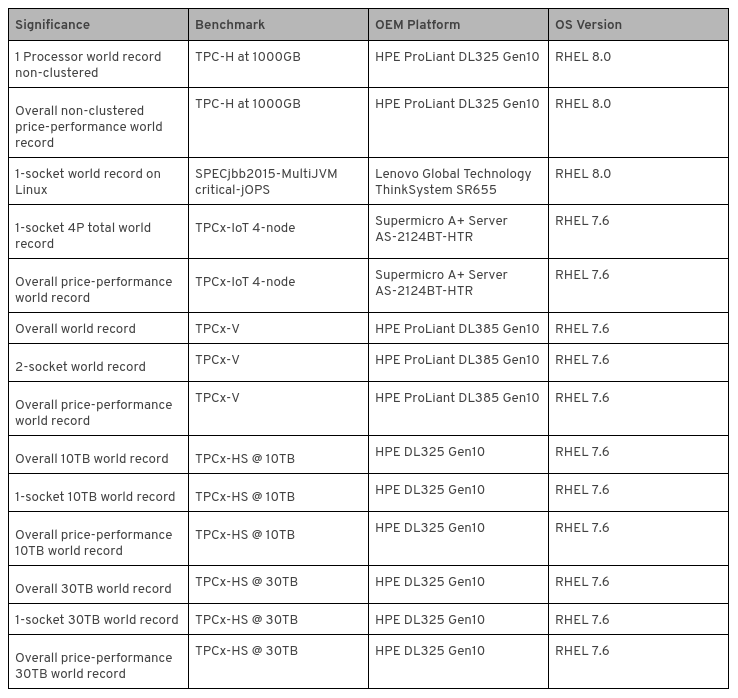As x86_64 hardware sees improvements in the area of CPU die size reduction, Red Hat has continued to work with our partners to better enable world class performance. Recently, AMD released its ROME line of processors, known as the AMD Epyc 7002 Series. With a die size of 7nm, AMD has achieved several new performance world records and many of these results have been with workloads running on Red Hat Enterprise Linux (RHEL) 7 and RHEL 8.
Leaning on our long history of collaboration, Red Hat and AMD have worked together to deliver enhanced performance to enterprise data centers and beyond. Red Hat’s development and performance engineering teams have been working on hardware enablement and validation of these ROME processors for more than a year, resulting in several benchmark publications using RHELx.
Red Hat engineering uses prototype hardware from partners to integrate partner specific changes that are pushed upstream into various supported RHEL.x versions. The Red Hat performance engineering team runs a variety of CPU, Memory, Disk and Network IO that ensure proper operation which enable peak performance. These benchmarks cover SQL Server (TPC-H), Java performance (SPECjbb2015), IoT gateways (TPCx-IOT), busy database workloads (TPCx-V) and big data systems (TPCx-HS).
Red Hat is working to enable world class enterprise performance on new hardware across supported architectures. Today, we’re pleased to share the new world records set by AMD partners with both RHEL 7, as well as the first set of results using RHEL 8.
Results1

Source: https://www.amd.com/en/processors/epyc-world-records
These benchmarks cover a broad spectrum of workloads. We believe they provide solid evidence that RHEL excels at handling scalable workloads and thrives in changing environments. We know this is important as enterprise customers place increasing demands on their infrastructure.
The ongoing support and collaboration with AMD and the ecosystem of ISV and OEM partners does not stop with benchmarks. It goes beyond performance to new chip and server features to make RHEL a natural choice for advanced projects, leading-edge implementations and other emerging technology efforts that our partners and customers may be engaging in. We are seeing OEM/ISV's use RHEL 7 and now RHEL 8 to run “extreme” workload benchmarks, and expect to see this role expand as more applications are certified on RHEL 8.
The confidence placed in Red Hat by our customers and partners like AMD is a motivator for expanding capabilities and delivering innovative features in the future versions of the Linux OS. Our continued goal is to be the trusted OS of choice for partners and customers alike, regardless of scale, architecture or complexity of workloads.
執筆者紹介
チャンネル別に見る
自動化
テクノロジー、チームおよび環境に関する IT 自動化の最新情報
AI (人工知能)
お客様が AI ワークロードをどこでも自由に実行することを可能にするプラットフォームについてのアップデート
オープン・ハイブリッドクラウド
ハイブリッドクラウドで柔軟に未来を築く方法をご確認ください。
セキュリティ
環境やテクノロジー全体に及ぶリスクを軽減する方法に関する最新情報
エッジコンピューティング
エッジでの運用を単純化するプラットフォームのアップデート
インフラストラクチャ
世界有数のエンタープライズ向け Linux プラットフォームの最新情報
アプリケーション
アプリケーションの最も困難な課題に対する Red Hat ソリューションの詳細
オリジナル番組
エンタープライズ向けテクノロジーのメーカーやリーダーによるストーリー
製品
ツール
試用、購入、販売
コミュニケーション
Red Hat について
エンタープライズ・オープンソース・ソリューションのプロバイダーとして世界をリードする Red Hat は、Linux、クラウド、コンテナ、Kubernetes などのテクノロジーを提供しています。Red Hat は強化されたソリューションを提供し、コアデータセンターからネットワークエッジまで、企業が複数のプラットフォームおよび環境間で容易に運用できるようにしています。
言語を選択してください
Red Hat legal and privacy links
- Red Hat について
- 採用情報
- イベント
- 各国のオフィス
- Red Hat へのお問い合わせ
- Red Hat ブログ
- ダイバーシティ、エクイティ、およびインクルージョン
- Cool Stuff Store
- Red Hat Summit

